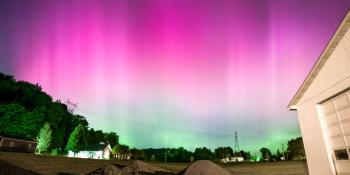Viendo archivo del miércoles, 2 marzo 2011
Informe actividad solar
Any mentioned solar flare in this report has a scaling factor applied by the Space Weather Prediction Center (SWPC). Because of the SWPC scaling factor, solar flares are reported as 42% smaller than for the science quality data. The scaling factor has been removed from our archived solar flare data to reflect the true physical units.
Informe de actividad Solar-Geofísica 2011 Mar 02 2200 UTCPreparado por NOAA © SWPC y procesado por SpaceWeatherLive.com
Informe conjunto USAF/NOAA de actividad Solar y Geofísica
SDF Número 061 Publicado el 2200Z a las 02 Mar 2011IA. Análisis de regiones solares activas y de actividad desde 01-2100Z hasta 02-2100Z Solar activity was low. Region 1164 (N25E08) produced
a C1/Sf x-ray flare at 02/1318Z, the only flare of significance
during the period. Region 1164 decreased in area, but remained an
Ekc type spot group with Beta-Gamma-Delta magnetic characteristics.
New Region 1166 (N10E77) rotated onto the disk as an Hsx type spot
group with Alpha magnetic characteristics. A flux region emerged in
the northeast quadrant near N20E40.
IB. Pronóstico de la actividad solar
Solar activity is expected to be low
for the next three days (03-05 March), however a chance exists for
an M-class event from Region 1164.
IIA. Resumen de la actividad geofísica 01-2100Z a 02-2100Z
The geomagnetic field was at active to minor storm levels for the
first 12 hours of the period and at quiet to unsettled levels for
the remainder. A recurrent coronal hole high speed stream remains
geoeffective. Solar wind speed at the ACE spacecraft remained
elevated at 640 km/s. The Bz component of the interplanetary
magnetic field began the period near -10 nT but slowly returned to
near neutral values by the end of the period. The greater than 2 MeV
electron flux at geosynchronous orbit reached high levels during the
period.
IIB. Pronóstico de la actividad geofísica
The geomagnetic field is
expected to be unsettled to occasionally active for the next three
days (03-05 March) due to the continued influence of the coronal
hole high speed stream.
III. Probabilidades del evento 03 Mar a 05 Mar
| Clase M | 35% | 35% | 35% |
| Clase X | 05% | 05% | 05% |
| Protón | 05% | 05% | 05% |
| PCAF | Green | ||
IV. Penticton 10.7cm flujo
Observado 02 Mar 113 Previsto 03 Mar-05 Mar 115/120/120 Media de 90 Días 02 Mar 088
V. Índices Geomagnéticos A
Observado Afr/Ap 01 Mar 018/031 Estimado Afr/Ap 02 Mar 015/017 Previsto Afr/Ap 03 Mar-05 Mar 015/015-012/012-010/010
VI. Probabilidades de Actividad Geomagnética 03 Mar a 05 Mar
| A. Latitudes Medias | |||
|---|---|---|---|
| Activo | 30% | 25% | 20% |
| Tormenta Menor | 15% | 10% | 05% |
| Tormenta Mayor-Severa | 01% | 01% | 01% |
| B. Latitudes Altas | |||
|---|---|---|---|
| Activo | 40% | 25% | 25% |
| Tormenta Menor | 15% | 15% | 15% |
| Tormenta Mayor-Severa | 10% | 05% | 05% |
All times in UTC
< < Ir a la visión general diaria
Últimas noticias
Últimos mensajes del foro
"It Was Fake, It Was HAARP" - What? 3Incoming Active Regions 364News Reporting 'High Chance Of Aurora's This Weekend 7AR3685 42Records from current activity discussion 11
Más temasApoye a SpaceWeatherLive.com!
Mucha gente viene a SpaceWeatherLive para seguir la actividad del Sol o previsión de aurora, pero con esta cantidad de tráfico se incrementan los costos del servidor. ¡Considere hacer una donación si disfruta de SpaceWeatherLive para que podamos mantener el sitio web en línea!

Hechos clima espacial
| Último evento clase X | 2024/05/15 | X2.9 |
| Último evento clase M | 2024/05/17 | M7.1 |
| Últimas tormentas geomagnéticas | 2024/05/16 | Kp6 (G2) |
| Días sin manchas | |
|---|---|
| Último día sin manchas | 2022/06/08 |
| Promedio de manchas solares mensuales | |
|---|---|
| abril 2024 | 136.5 +31.6 |
| mayo 2024 | 156.6 +20.1 |
| Last 30 days | 174.5 +64.4 |


